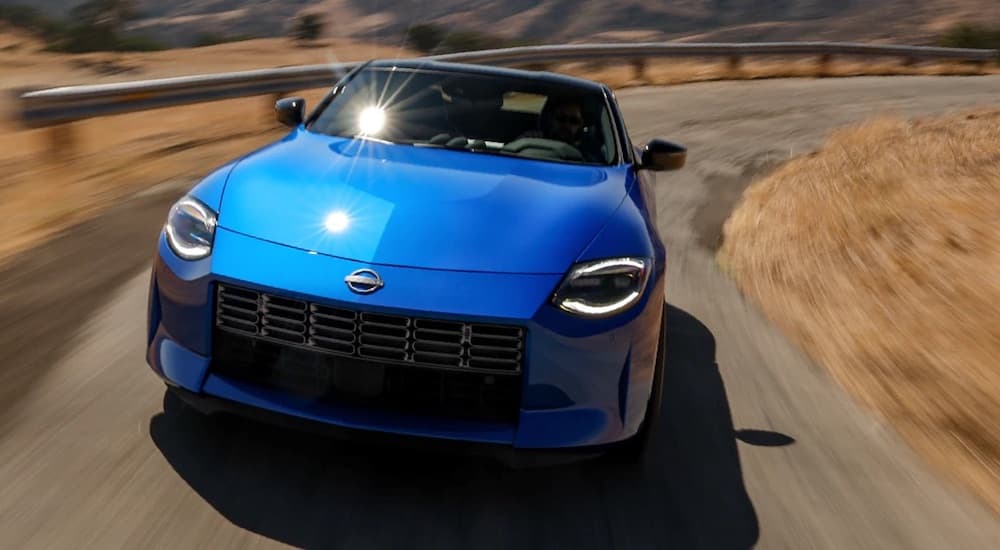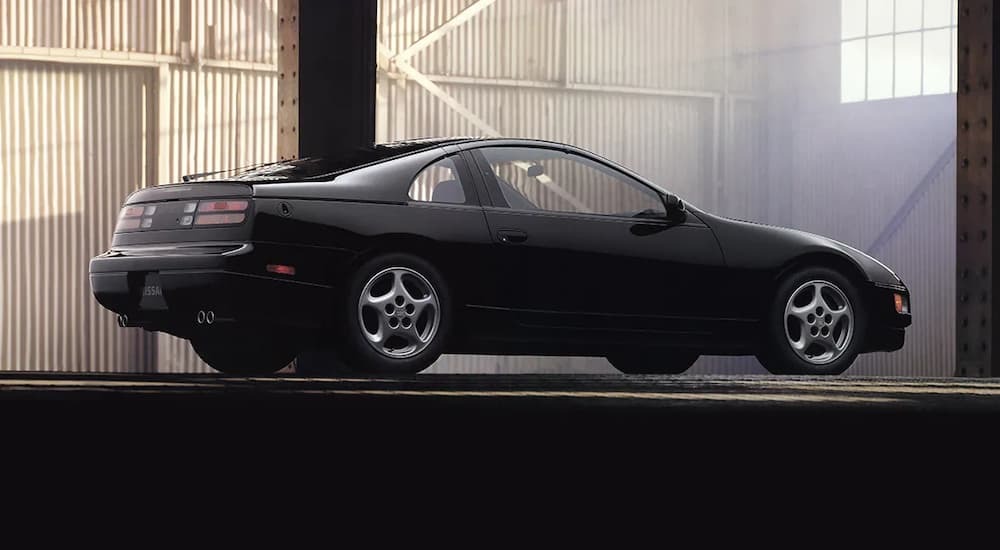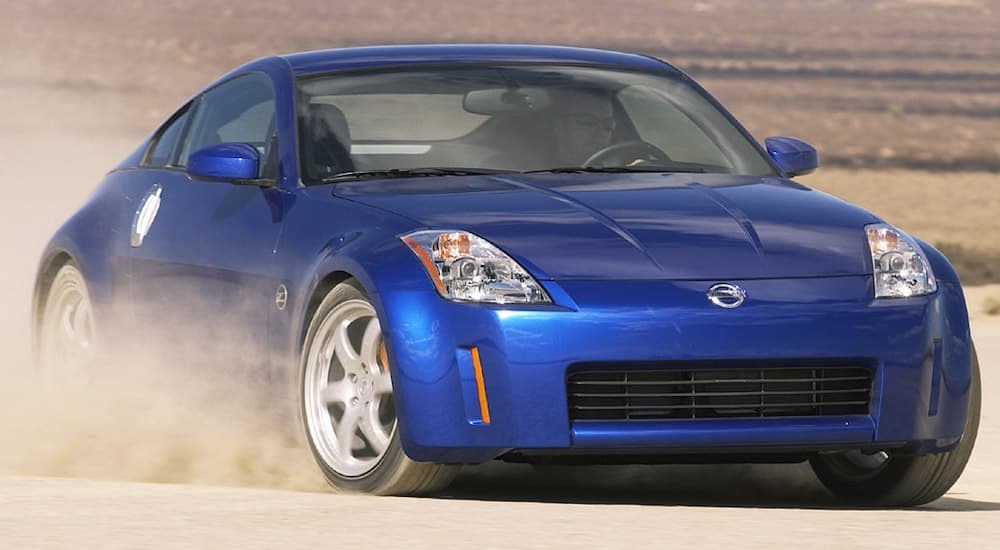What’s in a name? Prince, Elvis, and Madonna built their identities and careers in the spotlight using one name, a practice known as mononymity. As if hits like “Little Red Corvette,” “Blue Suede Shoes,” and “Like a Virgin” weren’t enough to define them, the artists’ forever sealed their fates in the spotlight, proving that nothing more was needed beyond their voices to identify their legendary talent. The same can be said about the Z, a sports car you’ll find at your local used Nissan dealership that proves one letter really can say it all.
An Unexpected Success: Meet the Original Z
Toyota’s debut of the 2000 GT sports car ignited fierce competition in the Japanese automotive industry as automakers rushed to design worthy rivals. Nissan’s answer was the Datsun 240Z, which debuted in 1970 and immediately overshadowed the Toyota. Yet, surprisingly, there wasn’t anything unique about the sports car. So, what made the 240Z so special?
The two-seat, rear-drive Z’s success was primarily due to Nissan offering something that so many other automakers couldn’t––a bargain sports car that delivered a top speed of 200 km/h with its 151-horsepower engine. In addition to this power, the Z handled incredibly well and set a new standard in the segment. Even European brands like Porsche took notice and realized they would need to up their game to stay on top.
An Ebb and Flow of Power
By the end of its first generation, the Datsun 240Z was well-established as an icon and paved the way for the 260Z in 1974. Unfortunately, the power and capability that defined the first-generation Z took a backseat as growing emissions regulations and safety standards made the Z heavier and less powerful. As a result, the 1974 260Z delivered only 139 horsepower, an output that threatened its reputation as a speed demon.
Overseas, the 260Z churned out 165 horsepower, a significant increase in power from the first-gen model. Fortunately, Nissan found a way to make the 260Z available in North America, but the model was short-lived as Nissan unveiled the sleeker and more powerful 170-horsepower 280Z. The 280Z, with its upgraded suspension, disc brakes, and longer wheelbase, was welcomed with open arms in Canada.
The Z’s ebb and flow of power continued throughout the 1980s, 1990s, and 2000s. For example, the 280ZX Turbo delivered 180 horsepower and 203 lb-ft of torque, impressive figures for the early 1980s. However, change was on the horizon as Nissan swapped the Z’s straight-six engine to a V6 to improve efficiency, stability, and handling. By the 1990s, the swap proved even more ingenious, with models like the 300ZX churning out 222 horsepower with its dual-overhead cams and variable valve timing. The twin-turbo 300ZX upped this power to 300 ponies, making the Z a world-class performer with a launch from 0 to 100 kmh in just five seconds and delivering a top speed of 250 km/h.
The Legend Leaves and Returns
With the Z’s performance seemingly perfected, the sports car went relatively unchanged throughout the early-to-mid 1990s, leaving fans anxious for an update. The update finally came in 1997 when Nissan stopped exporting the Z to North America, a decision that lasted until 2002. Drivers and industry experts anticipated the Z’s return and were proven correct with the debut of the 350Z in 2003. Delivering 287 horsepower, the 350Z was the most powerful yet but was quickly surpassed by the devastatingly beautiful 35th Anniversary Edition Z and its 300 horsepower engine.
The Z’s incredible return taught Nissan a valuable lesson: never let the sports car idle, at least not in the Canadian market. Unlike the 1990s, Nissan spent the 2000s pushing the Z’s capability even further throughout its fifth and sixth generations. These changes introduced the sports car’s official new name as the “Z” and proved that one letter was enough to define a sports car capable of delivering up to 400 horsepower without breaking a sweat.
Seven Generations Strong: Meet the 2023 Nissan Z
The 2023 Nissan Z ushers the sports car into its seventh generation and embodies the legacy started by the original 240Z with its 151 horsepower engine. “Z is the pure expression of thrill. It is Nissan’s passion wrapped up on four wheels,” says Nissan chief operating officer Ashwani Gupta. “The new Z retains its authenticity as a purse sports car to keep you connected to the road while bringing in the latest modern technologies to make sure the car can help keep you connected to your life.” It’s a modern marvel, a modern powerhouse, on wheels.
A Continual Flow of Power
The ebb and flow of power that characterized the Z’s history is quickly forgotten when you get behind the wheel of the 2023 Z. The 240Z’s 151-horsepower engine that turned heads in the 1970s is a far cry from the 400-horsepower engine sitting under the hood of the newest model. Nissan’s goal was to make the seventh-generation Z the fastest and most powerful yet. It’s safe to say the automaker delivered.
The 2023 Z’s twin-turbo engine delivers 400 ponies and 350 lb-ft of torque for jaw-dropping speed and immediate acceleration. By pairing the engine with an available 6-speed manual transmission, Nissan gives drivers a physical connection with the sports car for an exhilarating thrill behind the wheel. Add in the advanced launch assist control and the EXEDY high-performance clutch, and you’ve got one hell of a sports car.
Past, Present, and Future
Beyond the Z’s heart-stopping power, the car’s design is phenomenal because it blends the past, present, and future. The 2023 Z pays homage to its legacy with its iconic long hood, short deck, and lower rear stance, staples on every model since the original 240Z. Nissan ushers these vintage features into the present with the addition of LED exterior lighting, a rear spoiler, and a modern exterior palette that ranges from monotone colours like Black Diamond Metallic and Gun Metallic to two-tone options that pair a Super Black roof with Ikazuchi Yellow, Passion Red TriCoat, Everest White Pearl TriCoat, or Boulder Grey.
The 2023 Z guides the icon into the future with its digital cockpit that puts an array of cutting-edge technology at your fingertips or within immediate view. The simple radio of generations past is a far cry from the Z’s expansive touchscreen display and infotainment center that’s home to smartphone integration, navigation, and a host of in-vehicle apps. Modern touches like the Bose Audio system with Active Noise Cancellation and Active Sound Enhancement deliver another level of luxury, allowing you to enjoy every moment when you’re in the driver’s seat.
What’s in a Name?
The Nissan Z is one of the most beloved sports cars in the world, a feat that’s surprising when you look at the story of its origin. The Z’s debut was prompted by friendly competition against Toyota, Nissan’s biggest competitor on Japanese soil. Determined to deliver a rival to the Toyota 2000 GT, Nissan designed the 240Z in a hurry, using parts and methods already on hand. The result was miraculous––Nissan turned the ordinary into the extraordinary as the Z set a new standard of performance and handling for sports cars worldwide.
Over the next several decades, the Z’s evolution saw a continuous ebb and flow of power. However, the Z’s popularity remained steadfast, which speaks volumes about its design and handling. Its success continues today with the all-new, seventh-generation 2023 Z with its 400-horsepower engine and pedal to the metal mentality. It’s a modern marvel on wheels that deserves every moment in the spotlight, proving that one letter can say it all.






